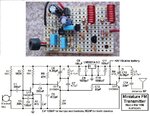jeolex
Member level 2
Dear friends.
I wanna make a fm transmitter with electret microphone for my elder aunt. We all live in same apartment, and sometimes my elder aunt need help. If we can listen her by our FM radio, when she need help, we can immediately go and help her. It was my main aim.
So I researched some circuit and I found one of them that seems solve my desire. Here website: http://www.talkingelectronics.com/projects/Spy Circuits/SpyCircuits-2.html
My circuit which I use it from website


NOT: Only different item from this circuit is Q1. I have used KTC9018 NPN transistor. I couldnt find 2N3563
My layout, I use Protheus ARES,

And my project as finished



!!!_SO WHAT İS MY PROBLEM_!!!
I have tried this project. I have tuned FM radio that is empty, then adjust variable capacitor for finding the same frequency. But I couldnt get the clear sound from radio. Microphone is not so sensitive, I have to speak so close to microphone in order to get my voice. And also my voice is sizzling. When I move the circuit to anywhere, connection has lost.
I will be very pleasure if you help me.
Best regards.
I wanna make a fm transmitter with electret microphone for my elder aunt. We all live in same apartment, and sometimes my elder aunt need help. If we can listen her by our FM radio, when she need help, we can immediately go and help her. It was my main aim.
So I researched some circuit and I found one of them that seems solve my desire. Here website: http://www.talkingelectronics.com/projects/Spy Circuits/SpyCircuits-2.html
My circuit which I use it from website


NOT: Only different item from this circuit is Q1. I have used KTC9018 NPN transistor. I couldnt find 2N3563
My layout, I use Protheus ARES,

And my project as finished



!!!_SO WHAT İS MY PROBLEM_!!!
I have tried this project. I have tuned FM radio that is empty, then adjust variable capacitor for finding the same frequency. But I couldnt get the clear sound from radio. Microphone is not so sensitive, I have to speak so close to microphone in order to get my voice. And also my voice is sizzling. When I move the circuit to anywhere, connection has lost.
I will be very pleasure if you help me.
Best regards.
